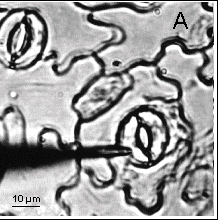 DESVC technic applied to intact guard cells (A. thaliana, C. communis,
V. faba).
DESVC technic applied to intact guard cells (A. thaliana, C. communis,
V. faba).
 Intact guard cells of Arabidopsis thaliana impaled with a microelectrode
during a discontinuous single-electrode voltage-clamp experiment.
Intact guard cells of Arabidopsis thaliana impaled with a microelectrode
during a discontinuous single-electrode voltage-clamp experiment.
Pharmacological properties of slow anion currents in intact guard cells of
Arabidopsis. Application of the discontinuous single-electrode voltage-clamp to different
species
More electrophysiological studies have been made on guard cells than any other cell type
of vascular plants. Characterisation of their ion channels has mainly been conducted using
the whole-cell patch-clamp technique applied to guard-cell protoplasts. The aim of this
study was to obtain recordings of ion channel currents in intact guard cells and
especially of S-type anion channels of Arabidopsis thaliana, a species of fundamental
genetic interest. Application of the discontinuous single electrode voltage-clamp (dSEVC)
technique enabled the first characterisation of potassium currents in Commelina communis
and of slow anion channels in C. communis and A. thaliana in intact guard cells to be
made. Inward potassium channels from A. thaliana were inhibited by external application of
TEA or Ca2+. In the presence of potassium channel blockers, slow anion channels were
elicited in almost all guard cells tested and were confirmed by application of anion
channel blockers. In A. thaliana, only anthracene-9 carboxylic acid was able to inhibit
slow anion current, to promote stomatal opening in the dark and to reverse the effect of
25 ÁM ABA under light. Use of a single microelectrode, and preservation of cell integrity
make this technique well suited for the study of ion channel regulation in species of
which guard cell protoplasts are difficult to seal.







